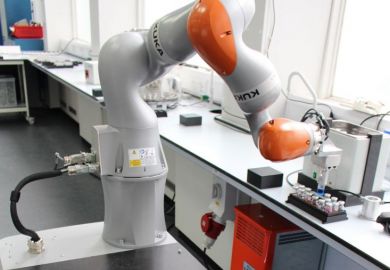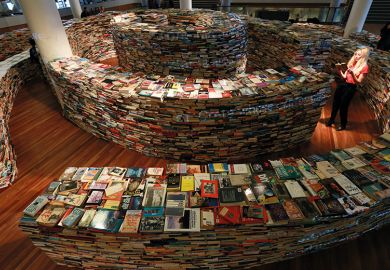Imagine a cathedral the size of St Paul's, cleaned beyond the standards of an operating theatre or the cleanest room in a laboratory. In a shaft of sunlight through a window floats a single grain of dust. This one grain in such a volume is representative of the density of dust grains in the space between the stars. The effect of the single grain in the cathedral is to divert sunlight, with the result that we can see the grain: the beam of light is at the same time attenuated. The same thing happens to the light of stars affected by grains in space. The attenuation due to one grain in a cathedral's volume is minute, but between a distant star and us lie many such volumes, one behind the other. The effect of countless dust grains may accumulate so much as to attenuate the light of stars behind by a huge factor - the clefts along the centre line of the Milky Way are due to clouds of interstellar dust. The grains may become visible as beautiful "reflection nebulae", such as the one surrounding the star cluster of the Pleiades.
Cathedral dust grains have an earthly origin - from people in the congregation or from the street outside the cathedral door. The origin of interstellar dust grains is the galaxy of stars themselves. From below the surfaces of the dying stars known as red giants are dredged up the chemical elements that they created from hydrogen by nuclear fusion; in the prime of their lives the stars released the energy of these processes by shining; in their death they disperse their ashes. Typical elements that are made in abundance are carbon, silicon and oxygen. These combine into a smog of dust grains around red giant stars; the grains are tiny fragments of amorphous carbon, graphite or even small diamonds. They are also made of silicate minerals - quartz or, in a common word, sand. The smog disperses into interstellar space as the star fades away and dies. Astronomers call these stars and nebulae by fanciful names such as the Toby Jug and the Homunculus.
As our solar system speeds into space, heading in the direction of the constellation of Hercules at a speed of 20km a second, it sweeps through those interstellar dust grains. A perpetual rain of them falls on the Earth; hundreds of tonnes a year. They can be collected by high-altitude aircraft; they can be collected from between the planets by spacecraft.
Some were collected in a sticky net by the Stardust satellite and returned to the Utah desert in January, and they are now in a lab in Houston.
Astrochemists will try to determine their stellar origin; physicists will try to read the history of their life in space, which has been inscribed on their surfaces by cosmic radiation.
In the chain of processes in space that turn atoms of chemical elements into dust grains lie molecules. Some of these molecules have been identified through their spectral emissions of millimetre and submillimetre wavelength radiation. They concentrate in so-called molecular clouds.
Hydrogen gas, H2, is the most common, made from hydrogen left over from the Big Bang or hydrogen that has been recycled, unburnt, from exploding or dying stars. Alexander Tielens's book The Physics and Chemistry of the Interstellar Medium lists about 200 types of molecules, some of them incomplete radicals, such as cyanogen (CN) or hydroxyl (OH), but others quite large, complex, complete molecules such as water (H2O) or ethanol (C2H5OH). Some of the interstellar spectral emissions and absorptions have not been identified: the molecules have been made in, and now inhabit, a strange interstellar environment not readily reproduced in a terrestrial lab. No one has come across them yet, except in their effect on starlight.
Molecular clouds are the densest parts of interstellar matter, with dark central regions shielded from external radiation. They cool and get more dense, and the densest lumps make new stars. Some of the detritus of molecules and grains that does not get drawn into a new star remains in orbit around it to make a planetary system. You and I, and the world we stand on, were made from stardust.
Tielens's textbook, which was originally written for PhD students at the University of Groningen in the Netherlands, builds the science into this picture. It sets the scene with a sketch of the galactic ecosystem, the way stars form from the interstellar medium and how they recycle material back into it. It describes the physics of the heating of gas and its cooling, and the chemistry of its constituent elements. It brings the stars into the picture, showing how the ultraviolet light from hot stars ionises the gas, how supernova explosions and other less energetic events shock the gas. It ends with the life cycle of interstellar dust and the repletion of interstellar material by infalling matter from surrounding galaxies. The book is modern, logical and clear, and will make a good textbook for advanced university courses.
Paul Murdin is a senior fellow at the Institute of Astronomy, Cambridge University.
The Physics and Chemistry of the Interstellar Medium: A. G. G. M. Tielens
Publisher - Cambridge University Press
Pages - 495
Price - £45.00
ISBN - 0 521 82634 9


